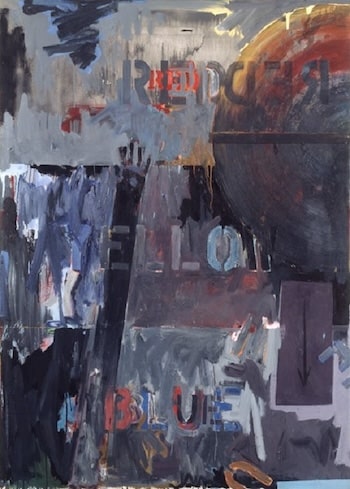Land's End, 1963 by Jasper Johns

These are the three primary colors stenciled by Jasper Johns onto his famous painting Land's End, completed in 1963. Starting from the three primary colors, an artist can, with the
addition of black and white, mix any of the colors within the spectrum. Nothing could be more sure. Nothing could be more stable. All of the colors that could possibly exist from three short
words: red, yellow, blue. Within the three sides of the mandala, so like a color wheel, everything can be located, measured and defined.
The colors begin to relate to one another as people do in a relationship. Our proximity to our partners allows us to locate ourselves on the color wheel. They provide a stable anchoring point
in rough seas or a pole star that allows us to navigate our lives. But what happens when those relationships break down? How do we define ourselves without our opposites?
In Jasper Johns' painting the stability of the triad of colors begins to give way. We lose our sense of direction and feel the soft sand of the beach beneath our feet slowly slip away as we are
swept out to sea. How did this happen?
In a Jasper Johns painting nothing is as it seems, and Land's End is no exception. When Rene Magritte made the famous statement about the painting of
the pipe "Ceci n'est pas une pipe." (This is not a pipe.), he was questioning how a painting of an object, in this case a
pipe, is similar or not similar to the actual object. In the same vein, Johns' questions in Land's End, and many of his pictures of the `60s, are whether the name of the color is actually
the same thing as the actual color itself, and maybe more importantly, how does anyone know or agree that a color like is red is not, for example, actually yellow. Where does red stop and yellow
begin? Is red defined by its opposite, for example, that which is not yellow or blue? Is red without some intrinsic quality, but just a description of relationships? Who decides?
These are a lot of questions, but this what happens when you think about a Johns painting - a lot of questions and not very many answers. We are beginning to get carried away now as the water
swirls around our feet and we see a large wave on the horizon. But maybe that is precisely that point, that there are no answers. There is no stability and we are not sure of anything. Nothing
has intrinsic value, only labels and descriptions. The things that we use language to describe are only defined by their relationships to something else and that everything is interconnected.
For a painting with stencils of the words of the three primary colors, there is not very much color in this painting, and there is a rarely a one-to-one correlation between the names of the
colors and the paint within the rectangles. The painting is mostly gray, but a mix of warm and cools, brown and blue grays, in fact the painting is practically an exploration of the way the
gray can interact with colors. Gray is the middle of the spectrum, a mixture of black and white, or the actual color that you get when you mix complementary colors together. If anyone needs an
example they can look at Gamblin's Torrit Grey, which is a gray, made up of all the remains of all the other paints that they produce in the paint factory. So in a very subtle way, gray could be
full of colors, maybe even the entire spectrum, but not necessarily in an amount that we would be able to distinguish individual colors. Our eyes blur (or average) the particles of pigments
together so that they appear gray, but at the microscopic level the particles still have their original color.
